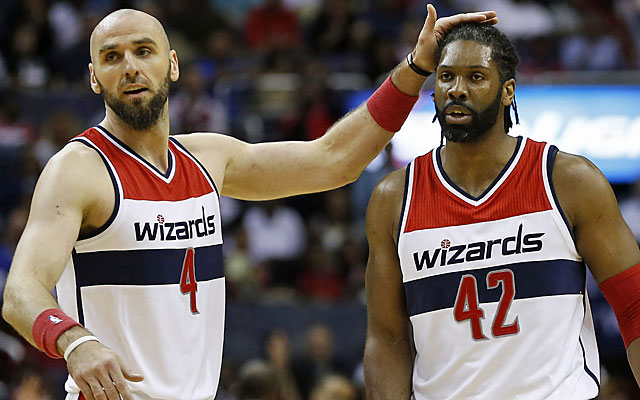When you look at the regular season Washington Wizards vs. the playoff Washington Wizards, a lot of metaphors come to mind. Dr. Jekyll and Mr. Hyde. Sleeping giant. One big rope-a-dope. It was simply jarring how different the Wizards were once they hit the playoffs. The regular-season Wizards were a bunch-it-up, double-big, grind-it-out team that shot a large percentage of mid-range jumpers, the most inefficient shots in basketball.
Suddenly, the Wizards faced the Raptors in the opening round and transformed into a small-ball juggernaut that pushed tempo and worked toward high-quality shots.
As we covered in their offseason report, the Wizards let Kevin Seraphin go, and instead picked up perimeter players in Alan Anderson and Gary Neal. Paul Pierce is gone, but Otto Porter showed that he's a perfect candidate to fill in through that role. If nothing else, simply replacing Seraphin with more wing players demonstrates that inherently the Wizards will have to play smaller at times on account of their roster construction.
There's no doubt that the Wizards need to play more throughout the regular season as they did stylistically in the playoffs. That's a much better team, and their success is proof of that. The question is how much of Washington's success in the postseason was attributable to those small-ball lineups, and whether the Wizards should fully embrace that approach this season.
There's ample evidence that the small lineup worked in the playoffs. Let's start with SBNation.com:
In that four-game sweep, the small lineup of Wall, Beal, Otto Porter, Pierce and Gortat saw 31 minutes of action in the four games and was the second-most used lineup of the series. (Remember, the most-used lineup with Pierce at power forward in the regular season played just 38 minutes together in 82 games). That group had an offensive rating of 131.8 and outscored the Raptors by 36 points per 100 possessions, per NBA.com.
The emergence of Porter, the No. 3 pick in the 2013 NBA Draft, was a major boon. He shot 50 percent from three against Toronto, giving Washington three credible shooters to play with a dynamite point guard in Wall and a solid pick-and-roll man in Gortat.
The small lineups didn't have as much success against the Hawks, but that was mostly because of defensive concerns. The small units still hummed offensively, even when Ramon Sessions replaced the injured Wall in the lineup.
Source: The Wizards are finally embracing the small ball revolution - SBNation.com.
Hold that last thought for a second, we'll come back to it. Clearly the small-ball lineup worked. Like we said before, that success was largely predicated on how they found shots with those lineups. From the Washington Post:
With a standard “miniscule sample size” caveat, (these lineups played a total of 163 minutes, including the playoffs), Gortat-plus-four-smalls units put up an Offensive Rating of 121 points per 100 possessions. This would have led the league by a sizable margin. Though the Wizards’ overall three point rate was 28th in the NBA at 20.3 percent during the regular season, those quicker combos took 31.3 percent of their shots from behind the arc, which would have finished seventh over a full season, just above the NBA champion Warriors. Those additional threes largely came from the complementary Wizards as Wall’s beyond-the-arc attempt rate dropped from its normal level while Beal’s stayed relatively constant:
Source: With Kevin Seraphin gone, Wizards can go all-in on small-ball - The Washington Post.
So that data's pretty convincing. Here's something interesting, though. Typically, the "big" lineup featured Nene next to Marcin Gortat, and the small-ball lineup featured Otto Porter and/or Paul Pierce at the 4. But in the playoffs, the Wizards' percentage of 3-pointers was actually pretty much the same (and slightly higher) with Nene on the floor than with him on the bench (20.8 percent with Nene on, 20.0 percent with Nene on the bench.)
And here's the real kicker: The Wizards took a higher percentage of shots from 3-point range (28.6 percent) with Nene and Gortat on the floor together than they did overall (27.6 percent).
How is that possible? Well, some of it has to do with the low rate the Wizards took with Seraphin (who signed with the Knicks this summer) on the floor. But when we really start to look at the Wizards' 3-point shooting with those two bigs on the floor in the playoffs, we see something that, albeit with a small sample size, really illustrates the key to this entire conversation. Here's the shot distribution (not field goal percentage) of the Wizards with that small-ball lineup featuring Gortat and Porter on the floor together in the postseason:

You'll notice that against the Hawks, those 3-point shots dried up quickly. The Wizards just didn't take as many 3-pointers vs. Atlanta, which leads you to believe that Atlanta probably defended that better. There's noise there, in particular John Wall's injury which took a major weapon away, but it also shows that against Atlanta, smallball didn't work as well.
Here's a look at those two lineups specifically: Wall-Beal-Pierce-Nene-Gortat vs. Wall-Beal-Pierce-Porter-Gortat and how they fared against their two playoff opponents. Bear in mind the very small sample size requisite to this being only two playoff series, one with John Wall missing for a big chunk of it. But if we're going to talk about what worked for the Wizards in the playoffs:

So the "big" lineup did well vs. Toronto, but the small-ball lineup absolutely blistered the Raptors. Meanwhile, the big lineup was anemic scoring-wise vs. the Hawks, but the small-ball lineup was absolutely shredded defensively. The net result was still far superior with the small-ball lineups, of that, there can be no doubt, but the small lineup wasn't good either, due to that defensive problem we mentioned previously.
Remember that we indicated that the Wizards threw up roughly the same (a little higher) percentage of 3-pointers with those big lineups? So how on Earth was the small-ball lineup that much more effective offensively?
It's not about the perimeter. It's about the interior.
Watch what happened when the Wizards put in that smaller lineup, not with how it affected the perimeter, but their ability to attack the rim.
See the space that they had to operate there? Watch the same thing happen as John Wall gets a one-on-one opportunity vs. a guard which is easy pickings for him.
The spacing is inherently better with the small-ball lineup, not only because of the 3-point threat, but specifically because of the space it operates inside for Washington's cutters, slashers and dashers to attack the rim. The numbers with Porter/Pierce playing the 4 vs. Nene in the playoffs are simply astounding when it comes to at-rim play.

Surprisingly, these numbers didn't shift dramatically when we looked at just the Hawks series. The small-ball lineups were still way better at the rim vs. a much better defensive team in Atlanta, and even defensively, the problems weren't at the rim. The Wizards gave up 48 points in the paint per 48 minutes with both lineups on the floor, dead even.
So it's settled, right? The Wizards will embrace more smallball this season as they should and that will be the end of it. Hurray the fad.
Well, pump the brakes a minute.
First, there's the uncomfortable Wittman aspect. Randy Wittman eschews metrics for gut-feeling, and is pretty adamant about defending the mid-range jumper while throwing out the importance of any advanced metrics. Wittman saw what a different offensive approach could do for the team, and went right back to the same principles. The odds are not great that he's suddenly going to soften and embrace a new style that runs contrary to what he's coached. (He might defend such ideas by simply saying "you take open shots," which ignores that the offense's entire design is to create the open shots it wants and the defense's entire design is to prevent those shots, but anyway ...)
Second, the small-ball tool is a great one to have in the bag (much like analytics on top of scouting, film review, player feedback and chemistry, I might add) but it's not fullproof. Look at those defensive numbers for the small lineup vs. the Hawks again. Now imagine instead that the Wizards had gotten past the Hawks and faced the Cavaliers, not with Kevin Love and Anderson Varejao, but the twin behemoth attack of Tristan Thompson and Timofey Mozgov. That small-ball lineup would likely have been shredded defensively, and they would have needed that bigger lineup.
The point in all this is that as teams seem to be scrambling over one another to try and out-small each other after watching the Warriors win the title in a truly bizarre Finals with Draymond Green playing center most games throughout the season (I'm looking at you, Larry Bird), it's important to remember that just as many teams will run counter-tactics. The Grizzlies are an obvious Western Conference example, and while Love will still get most of the minutes when healthy, you can bet the Cavs won't hesitate to turn to the super-big lineup that nearly won them the title.
Developing Otto Porter will be crucial for the Wizards this year. Playing more three-guard lineups will only increase their 3-point volume, which is nothing but good for them. The small-ball lineup can and has crushed for the Wizards. However, to say that there's this big sea change necessary is flawed, and to believe that just because the Wizards let Kevin Seraphin go that they'll embrace it whole-heartedly is also not without problems.
The Wizards learned what can be effective for them last spring. They'll use that to their advantage when the time comes. But the only thing better than being able to use a small-ball lineup over a traditional two-big lineup is the ability to use either when it's called upon. Slow down on hyping the smallball revolution, especially when it comes to the Wizards, and embrace the idea of versatility ... that is, if the Wizards embrace the fact that they have it.























